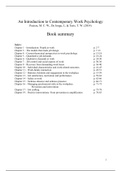Samenvatting
Summary An Introduction to Contemporary Work Psychology
- Instelling
- Tilburg University (UVT)
Uitgebreide, gestructureerde samenvatting van het boek 'An Introduction to Contemporary Work Psychology' geschreven door Peeters, M.C.W., De Jonge, J., & Taris, T. W. (2014). ISBN: 5536.
[Meer zien]





